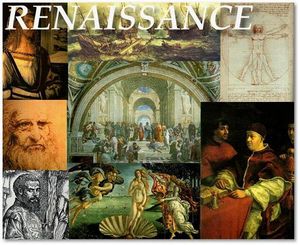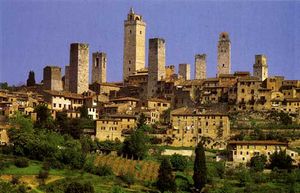Renaissance Review
| AP Psychology | Current Events | Resource Room (SETSS) |
|---|---|---|
| Period 1 | Periods 3 & 5 | Period 8 |
| Mr. Ott | Mr. Ott | Mr. Ott |
Aim: What was the Renaissance?
Do Now: What major time period (era) took place before the Renaissance?
The Renaissance

The Renaissance Period (1350-1600) was the transition period between the Medieval Era and the modern world. The word renaissance means "revival" or "rebirth". This was a period of great achievements in the arts and sciences combined with deep religious concerns. The Renaissance became one of the most productive periods in all history.
About 1450, European scholars became more interested in studying the world around them. Their art became more true to life. They began to explore new lands. The new age in Europe was eventually called “the Renaissance.” Renaissance is a French word that means “rebirth.” Historians consider the Renaissance to be the beginning of modern history.
The Renaissance began in northern Italy and then spread through Europe. Italian cities such as Naples, Genoa, and Venice became centers of trade between Europe and the Middle East. Arab scholars preserved the writings of the ancient Greeks in their libraries. When the Italian cities traded with the Arabs, ideas were exchanged along with goods. These ideas, preserved from the ancient past, served as the basis of the Renaissance. When the Byzantine empire fell to Muslim Turks in 1453, many Christian scholars left Greece for Italy.
The Renaissance was much more than simply studying the work of ancient scholars. It influenced painting, sculpture, and architecture. Paintings became more realistic and focused less often on religious topics. Rich families became patrons and commissioned great art. Artists advanced the Renaissance style of showing nature and depicting the feelings of people. In Britain, there was a flowering in literature and drama that included the plays of William Shakespeare.
Renaissance Life

Please see the article Renaissance life for further detail.
Causes & Effects of the Renaissance
Causes:
- The Crusades
- Cultural Diffusion - Ottoman Empire preserved Greek & Roman Culture and added Islamic Culture to society
- Trade - with Asia & Europe through Istanbul
- Rise of Middle Class - because of trade, more specialization = growth of wealth
- The Black Death (Plague) - questioning the existence of God and Church since whole families were destroyed
Effects:
- Age of Exploration - Technology from Asia and Ottoman Empire
- Emergence of Middle Class - Wealth from Trade
- Emergence of Italian City-States - from Trade
- The Protestant Reformation
- Martin Luther - Questioning the Catholic Church and the power of the Pope
- Catholic Church power lessened as Royal (King & Queen) power grew - leads to Age of Absolutism
- Inventions
- The Printing Press - Gutenberg recreates the Bible for the common person and in each countries language
- Da Vinci - Inventions for military use
- Art & Architecture
- Explosion in Art - Sculpture and Painting
- Architecture - Revival of Roman & Greek Engineering
- Free Thinking (Humanism)- People starting thinking about themselves instead of the church
Classwork & Homework
Lesson PowerPoint: The Renaissance - Overview
Lesson Video:
- The Renaissance
- Renaissance Dance 1 (Elizabeth, (1998)
- Renaissance Dance 2 (Shakespeare In Love, (1998)
- Renaissance Dance 3 (Shakespeare In Love, (1998)
- Woman in a Man's Profession (Shakespeare In Love, (1998)
Lesson Activity: Renaissance introduction & Overview
Homework: Assignments
- Teaching Model: Co-Teaching
- Special Education Teacher will work with All students General Ed and Special Ed.
- Special Ed Students:
- Teacher will read-aloud to students when necessary.
- Teachers will break down assignments into smaller tasks.
- Teachers will work with students on vocabulary acquisition by breaking down words into prefixes/suffixes and etymology.
- Teachers will group students according to learning style inventory as a homogeneous group.
- Teachers will keep students on-task by managing distractions and on-task behavior.
- Teachers will modify note-taking by modeling notes from PowerPoint to chalkboard/whiteboard.
- Teachers will differentiate lessons by using; verbal cues for auditory learners, graphic organizers for visual learners, and hands-on cues for tactile learners.
- Special Ed Students: